A Jam-Packed November
By Jeremy Day, McMurdo Station correspondent
December 12, 2016
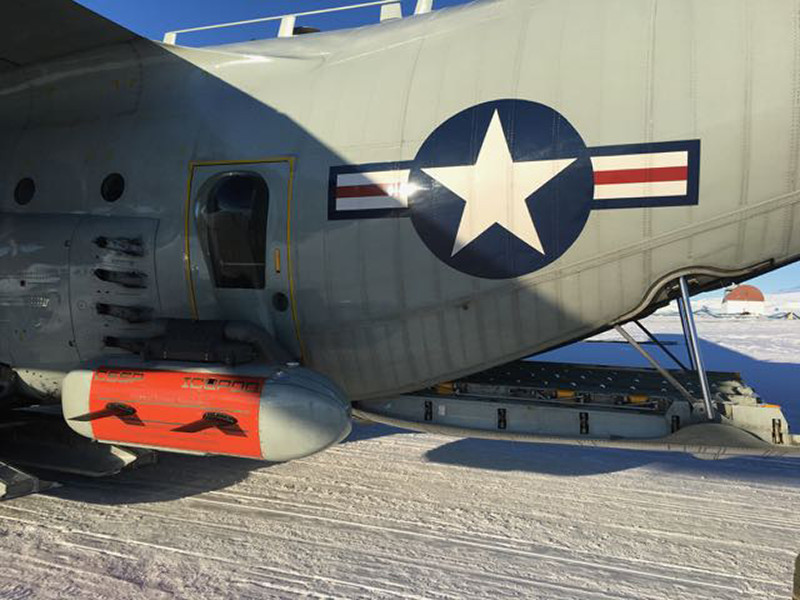
Photo Credit: Jeremy Day
The orange IcePod attached to the side of an New York Air National Guard LC-130 is one of the key instruments of the ROSETTA science team’s project to map the complete cross-section of the Ross Ice Shelf.

Photo Credit: Jeremy Day
A South African Safair L-100 (left) and a New Zealand C-130 are parked at Pegasus Airfield.
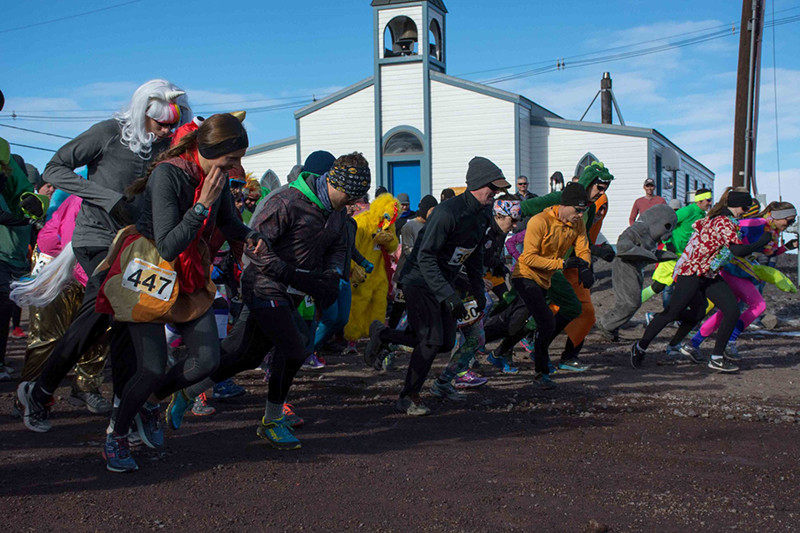
Photo Credit: Mike Lucibella
Runners in colorful outfits take off on the Turkey Trot, the annual Thanksgiving 5K run at McMurdo Station.
October left our icy little town with quite the bang: the annual Halloween weekend party. And like the Big Bang of cosmological fame, the excitement seemed to just keep going. Between holidays, ever-increasing flight traffic (both aviation and avian), distinguished visitors and landmark science events, November in McMurdo feels like it rocketed by.
As the number of LC-130 Hercules planes on the continent grew throughout the month, more science missions have been able to fly. In addition to the usual field camp setups, the Ross Ocean and ice Shelf Environment, and Tectonic setting Through Aerogeophysical surveys and modeling (ROSETTA) missions started flying across the Ross Ice Shelf as well. The researchers are using a bundle of instruments called IcePod mounted to specially modified LC-130 to map the ice, and the sea floor below, to better understand the ice shelf systems of Antarctica. During the flights the IcePod gathers data on gravity, magnetics, radar, LiDAR and imagery data, as well as an airdropping of buoys into the Ross Sea for a related project. Speaking of science taking flight, the first Long Duration Balloon payload was launched on November 29, the earliest LDB launch from the station.
Science on the continent is an international effort. A Royal New Zealand Air Force (RNZAF) C-130 and a South African Safair L-100 have been helping to carry people and cargo back and forth from Christchurch since C-17 flights ceased early in December, allowing our planes to fly more on-continent missions by sparing them their usual thrice-weekly intercontinental missions. It’s just one small example of how international the scientific effort is down here. American, Italian, New Zealand, and sometimes others fly in on the same aircraft down and back. The New Zealand Air Force help crew the U.S. LC-130s. Pallets of cargo are assembled in Christchurch by the RNZAF, but handled on-continent by mostly U.S. cargo teams. The Italians fly in on Safair flights. The Kiwis delivered, built, and maintain the three wind turbines that feed into the central power grid for both stations. And there’s plenty more, down here we’re all one big “Ice family.”
On November 10th, Secretary of State John Kerry became the highest ranking U.S. official to ever visit the continent. He flew in for a whirlwind tour of the station, visited some of the camps in the McMurdo Dry Valleys, took a walk in the Scott Base pressure ridges and held a question-and-answer session in the galley. While out at New Harbor, he got to say “hi” to a wayward Adelie penguin that came up to investigate, as they are wont to do.
Later in the month, just as everyone back in the States was tucking in to turkey, mashed potatoes, stuffing and pie, we were getting together to celebrate Thanksgiving in our own McMurdo way. It’s mostly the same way we celebrate at home: gratuitous gorging on food and running a footrace or two. Well, maybe the footrace isn’t the traditional way that people at home might celebrate Turkey Day, but dozens of people competed in the Turkey Trot and the Turducken 5K’s.
Though we can’t spend time with our families, except for those lucky few that have family down here, we’ve developed a sort of surrogate family to gather around tables with and pass the gravy to. We come from a plethora of backgrounds, calling hundreds of different places home. Here, however, we find a surprising amount of commonality despite disparate origins; with such close proximity and shared experiences here, we’ve bonded quickly and with great strength. To be living on the Ice is to be part of a big, beautifully weird family. So we give thanks for that.
Now, the temperatures continue to rise, and snowmelt rivers start flowing through the drainages in town. Our little icy town becomes our little dusty town as we careen towards the new year and everything that has to bring. Especially Icestock.
The First Signs of Summer
By Jeremy Day, McMurdo Station correspondent
November 8, 2016
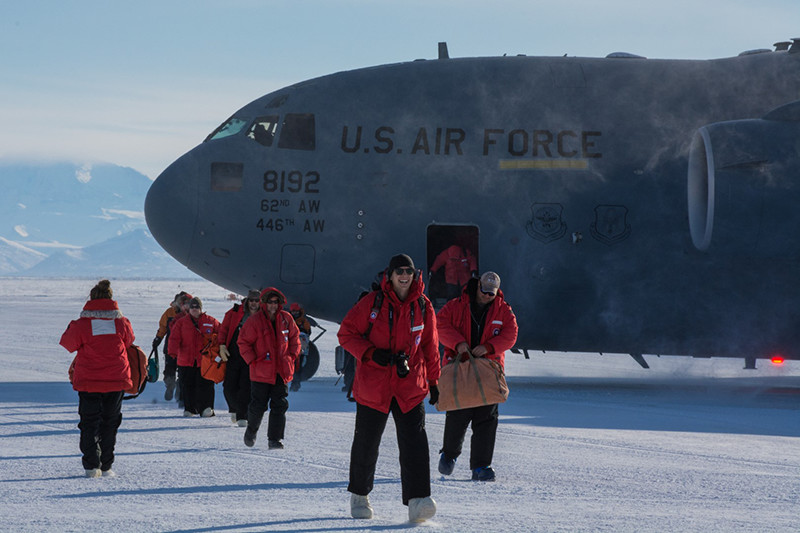
Photo Credit: Mike Lucibella
Excited station residents disembark from a U.S. Air Force C-17 in mid-October.

Photo Credit: Gordon Hamilton
Scientist Gordon Hamilton conducts fieldwork on the Helheim Glacier in Greenland during a previous season.
It’s October again, and while back in the States the landscape is starting to enter its its seasonal slumber—with leaves turning colors and whispers of winter felt in the autumn breezes—here in McMurdo, October in the Southern Hemisphere brings a different sort of significance. On October 3rd, the first flight of “Mainbody” landed at the Pegasus White Ice Runway on a cold and sunny afternoon, ushering in the start of the busy summer research season. More than 100 people dressed in the ubiquitous Big Red parkas disembarked from a U.S. Air Force C-17 and took the hour-long ride to an outpost at the end of the world that so many people call their temporary home.
Each year as part of Operation Deep Freeze, the military support component of the NSF-managed U.S. Antarctic Program, C-17s from Joint Base Lewis-McChord in Washington State return to Pegasus to haul down the majority of support staff and scientists for both the U.S. Antarctic Program and Antarctica New Zealand, whose Scott Base is just “over the hill’ from McMurdo Joining them on these flights are thousands of pounds of scientific equipment, vehicles, spare parts and other essentials for the hectic season ahead. Most importantly for those folk who have been here since Winfly or before, this means fresh food and mail again! Even one pallet of pears and arugula make all the difference to those who have been starved of “freshies” since the last batch arrived in July.
But on a bittersweet note, this first flight not only means we have to bid farewell to friends departing after a winter spent together in the tight-knit small community, but also to the season of Winfly entirely. A staple in McMurdo life since 1967, planned monthly flights starting next winter means that the significance of the planes in August after a winter of quiet darkness at Pegasus will become just a part of the stream of cargo and personnel coming and going like the auroras shimmering overhead.
And like someone stretching and yawning before climbing out of bed to start the day, the station has been bustling with science groups starting their research. The sound of helicopters echoes from Observation Hill as the helos carry loads of supplies across the sea ice to camps in the Dry Valleys. Kenn Borek Air-operated planes wing their way to Amundsen-Scott South Pole Station or smaller field camps, bringing in carpenters and supplies prepare them for the austral summer. Forklifts rumble around town carrying fuel hoses and boxes for ice core samples while tracked vehicles like Pisten Bullys and Haggelunds trundle down the sea ice roads en route to dive huts and seal monitoring camps. The small FAA Challenger airplane arrived with the staff to certify the runways and skiways, including the new Phoenix runway, slated to replace Pegasus later this season.
Things are starting to settle into something of a routine. Old friends reunited after the austral winter off the Ice are finding their familiar places. We’ve all dusted out the cobwebs that were cluttering our memories of our jobs, and the new folks on station have hit the ground running and are smiling and laughing with the old hands at dinner. As November arrives, life at McMurdo has reached full tilt as the colors of sunset have faded away into perpetual sunshine; It’s a state that speaks to the always-moving nature of the life of the station.
During this time heady season, however, we sadly had to cope with the sudden and unexpected loss of a McMurdo regular, Gordon Hamilton. Hamilton was here studying the ice shelf as part of a group from the University of Maine, and had been doing so for many years. His death in the Shear Zone came as a shock to everyone, even to those who did not know him. It was a stark reminder that no matter how comfortable this continent can feel to those of us nestled in the comparative safety and creature comforts of McMurdo, this is still a dangerous place. A memorial service was held in the Crary Library, where members of his research team, friends, and colleagues shared memories of him. It was a somber farewell as he left the ice for the last time.
The Calm Before the Summer
By Travis Senor, McMurdo Station correspondent
October 3, 2016
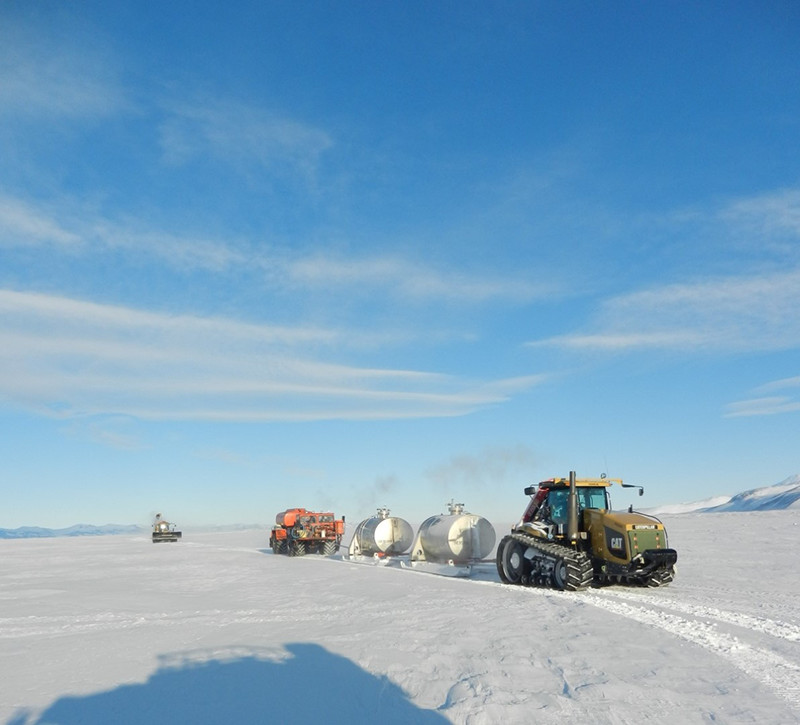
Photo Credit: Kory Hottel
The Black Island Traverse delivers fuel and supplies to the small island that holds McMurdo's communications links off of the continent.
September is the last month of relative quiet before the mad rush of activity that ushers in Mainbody, the short Antarctic summer season. This September at McMurdo was relatively quiet, especially compared to last year when the preseason Winfly flights lasted well into the beginning of the month. Quiet weather made for a quiet month.
The first science of the season got underway as both the Davis and Cassano research groups began conducting their research apace after flying in late last month. While the Cassano group will wrap-up their study of the atmosphere by the beginning of October, the Davis group’s seal research will stay on to continue operations well into the austral summer.
The South Pole Operations Traverse (SPOT), team also arrived in late August, and began their prep work to be ready for operations in early to mid-October. They will be transporting thousands of gallons of fuel over the Ross Ice Shelf, up the Leverett Glacier, onto the Polar Plateau and then the rest of the way to Amundsen-Scott South Pole Station. There are three such traverses scheduled this year which are essential to keeping the South Pole fueled and supplied.
The first fuel traverse was made to Black Island, delivering fuel and other supplies necessary for opening the station for the coming summer. The Black Island facility maintains McMurdo’s communications onto and off of the continent.
Preparations are also underway for opening the helicopter refueling station at Marble Point, the gateway to the McMurdo Dry Valleys. McMurdo’s sea ice experts headed out in late September to check the safety of an over ice route across McMurdo Sound. This event, known as the Marble Point Traverse, will be used to deliver fuel to the camp as it opens in early October.
Lastly, everyone on station is preparing (both mentally and logistically) for Mainbody as it approaches. For some, this means getting ready to leave the Ice for home or other far-flung (and warmer) destinations. For others, it is settling in for the flurry activity of the coming summer.
The Morning Light of Winfly
By Travis Senor, McMurdo Station correspondent
September 1, 2016
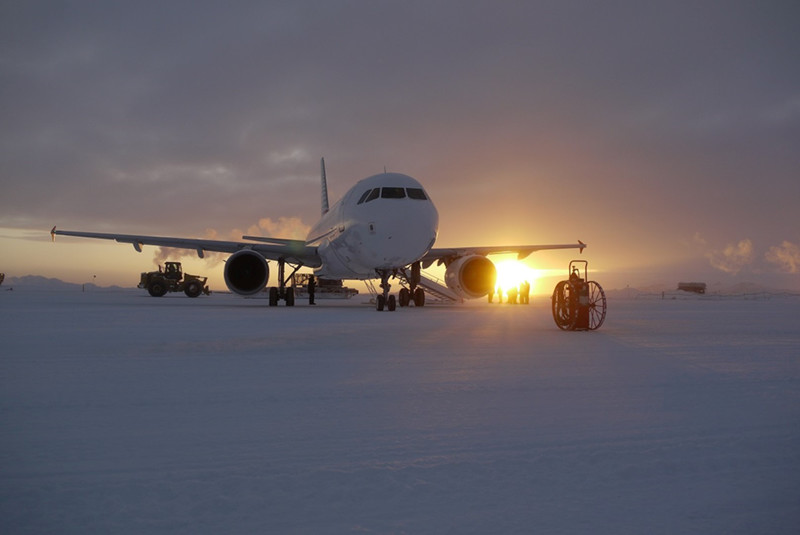
Photo Credit: James Penkusky
The first flight of Winfly, an Airbus A-319, lands at Pegasus field with the sun still low in the sky.
August is, for many, the end; the end of winter, the end of the night and an end to the long quiet of the dark polar months. The sun returns, and with it brings a veritable horde (at least in the eyes of the wintering population) of fresh faces arriving on station, both newcomers and veterans alike. For these new arrivals, August marks a beginning; to the coming summer, to new experiences and to a wealth of scientific activity which brings all of us here in the first place. Of course, it also means Winfly.
This Winfly saw the arrival two science groups on station. The first, Randall Davis’s group, is on station to study if and how Weddell seals use Earth’s geomagnetic field to navigate under the sea ice and across short distances to return to breathing holes. During Winfly, this group will be taking metabolic measurements of Weddell seals to help test this. The second group, led by John Cassano, will be conducting UAV flights at Pegasus Runway on the McMurdo Ice Shelf to collect atmospheric data and to observe the late winter atmospheric boundary layer in the vicinity of McMurdo Station. With safe routes already scouted and laid out, the sea ice was ready for arriving research groups, it promises to be another solid year for Winfly science at McMurdo.
The sun also returned to McMurdo in late August, after an absence of several months. Its arrival was acutely felt as the daylight came racing back, seemingly much faster than when it gave way to perpetual darkness just a handful of months ago. However, it is never an unwelcome sight and several of the station’s residents took the opportunity to view the first sunrise of the year from nearby Pegasus Airfield on August 20. Unfortunately, despite warm temperatures and almost complete lack of wind, clouds obscured the sun that day. It was an altogether perfect day otherwise, even though it fell just short of its full promise. There will be more than enough sunlight to be had soon enough, as it continues its ascent into continuous daylight.
And with that, winter ended. It was soon followed by a series of flights arriving from New Zealand that almost tripled the population on station. The calm quiet of winter, even with regular flights in June and July, was over, replaced by a flurry of activity and excitement. The entirety of Winfly flight operations concluded in only a week (after a few expected weather delays, par for the course this time of year), though for those involved it may have felt like more.
There is one thing that August does not mark the end of: the friendships and personal connections that are built over the course of the long polar winter.
Goodbyes are said and hugs are given, as a handful of flights head north carrying those whose time here has come to an end. Ultimately, those personal relationships and friendships that come to define so much of our experience here in this place, will, in their own way, endure far beyond the fixed confines of our deployments. The long months spent in isolation and close confines bring an intensity and depth to our interactions that, in a different place, might take years to develop. But here, in Antarctica, those relationships are the foundation on which all of our memories of this place are built, the ones we will keep with us long after we have left it.
An Independence Day Barbecue Before Sunrise
By Travis Senor, McMurdo Station correspondent
August 9, 2016

Photo Credit: Elizabeth Widen
Taken from Arrival Heights, the late winter auroras and glow of the sun just below the horizon light up the skies over Ross Island.
The sun is starting to return to McMurdo, and winter races toward its inescapable end.
Like its summertime counterpart back in the United States, July in McMurdo kicks off by celebrating our nation’s independence. This year featured an actual charcoal barbecue, the smell of which brought back memories of more temperate summer months, as well as a carnival and a talent show, where the station’s residents showcased abilities ranging from the serious to the hilarious. To top it off, McMurdo held what is possibly its first officially-sanctioned outdoor 4th of July parade. Members of every department participated and some crew members from Scott Base attended, giving the event an international flavor. While it was not a long parade by any stretch of the imagination, lasting only a couple of minutes, it certainly was one of the more memorable any at McMurdo have had the opportunity to witness.
As is the new winter norm, mid-July also heralded the arrival of a U.S. Air Force C-17 cargo plane, though not without the expected several days of weather delays. The plane was loaded with mail, freshies and enough new personnel to result in an almost 20 percent turnover of the entire station population. It was by far the largest winter flight to date, and one that may help set the tone for the future as McMurdo moves fully into year-round operations.
Arriving on that flight were personnel tasked with prepping the sea ice for use by scientific groups arriving at Winfly, the early part of the summer season just a handful of weeks away. Work started in earnest as McMurdo’s sea-ice expert began surveying and marking travel routes across the ice to pre-designated science camps. Other members of the community traveled out with him as well to aid in the difficult physical work, and also to take advantage of the unique chance to travel outside of town and learn about the dynamics of sea-ice movement first-hand.
Lastly, as July wears on, the days, literally, get longer and a day-night cycle returns to McMurdo. For many of the wintering crew, it can be a shockingly abrupt transition out of the constant darkness. However, the return of the sun is always welcome, as it brings with it spectacular views of Mount Discovery, Black and White islands and the Royal Society Range, all bathed in soft pinks and oranges of a continual sunrise and sunset. It is a calm and beautiful prelude to the frenzied activity of Winfly just around the corner.
McMurdo's Shortest Day
By Travis Senor, McMurdo Station correspondent
July 11, 2016
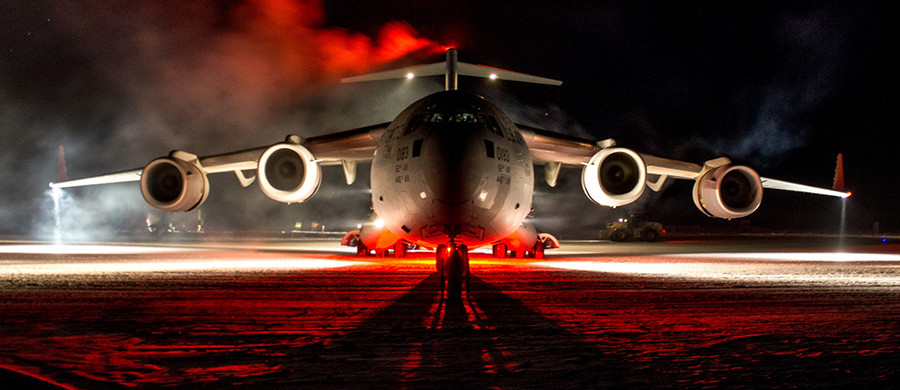
Photo Credit: Travis Bigelow
A U.S. Air Force C-17 lands at Pegasus Runway on June 8.
Midwinter. It’s the shortest “day” of the year, a word that is largely irrelevant on a station that hasn’t seen any sunlight for several weeks. June is the darkest part of the winter and the halfway point, for most, towards going home.
But for some, June was just the beginning of a new season on the Ice. A U.S. Air Force C-17 Globemaster III from Joint Base Lewis-McChord, Wash., landed at Pegasus Airfield on June 8th, carrying equipment, personnel, “freshies” and long-awaited mail. Multiple departments on station worked a long, very cold day to ensure the successful completion of flight operations. McMurdo’s kitchen staff also put in extra time to ensure that airfield crews would still be able to return to a hot meal once back to the station.
The kitchen staff also plays a large role in the usual highlight of June: Midwinter Dinner. The only uniquely Antarctic holiday, Midwinter is celebrated across the entire continent and into the Sub-Antarctic region. Each wintering station crew shares greetings with the others, cementing the shared experience of the Antarctic winter. McMurdo and Scott Base each also held their own special celebrations, where residents of both stations gathered to share excellently prepared food and beverages and generally enjoy the festive atmosphere of the midway point of the winter season. McMurdo and Scott Base kitchen staff combined to showcase their culinary talents, and, as is the case every year, community members from every office and trade combined efforts to make the celebrations happen.
But the program’s major event of the month was a rarity not seen for almost 13 years: a medical evacuation (“medevac”) from the South Pole. With the advent of winter flights, McMurdo Station became the backup access and exit point for any outgoing personnel from Pole. Operations, communications, fuels, carpenters and numerous other departments across station worked extra time to ensure that McMurdo and the Pegasus Airfield would be ready, if needed. Crews stayed on standby and rotating on-call shifts for days until the medevac was successfully completed and all personnel were safely back in Punta Arenas, Chile. All told, it was a remarkable effort by the members of the McMurdo community--and wintering personnel across the continent--to be ready to support and provide assistance to this urgent need.
It was, in many ways, a much more eventful June than those past, but once again these events highlighted the best parts of McMurdo’s strong sense of community, and how that community thrives together despite the long isolation of the austral winter.
The Early Winter Lull
By Travis Senor, McMurdo Station correspondent
June 2, 2016
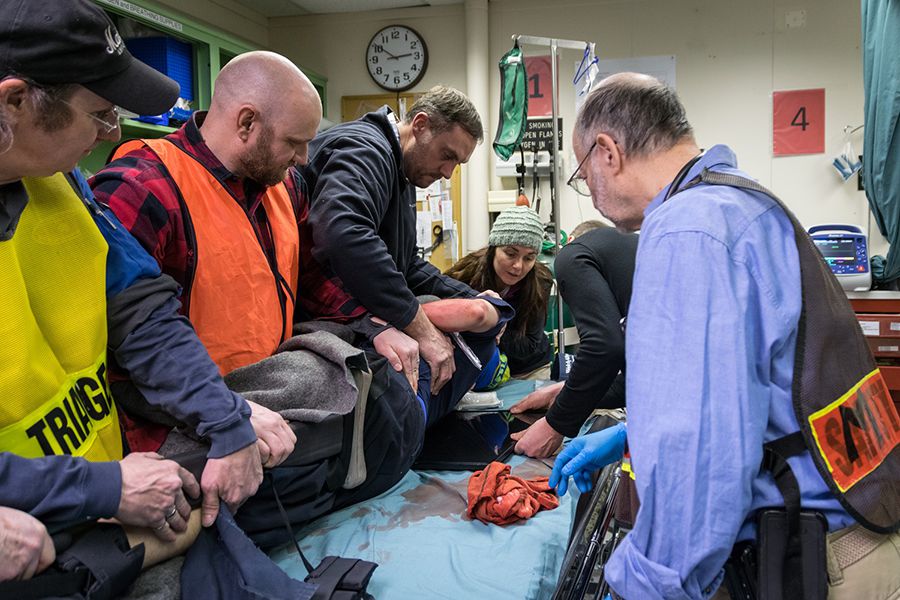
Photo Credit: Rebekah Osgood
Community volunteers tend to a simulated patient as part of the annual Mass Casualty Incident Drill.
May is the longest part of the “new” winter at McMurdo Station, falling right in the middle of the longest gap between flights all season. It makes for a quieter period than others during the winter, with no comings or goings, and project work continuing at a steady pace.
This quiet period has its perks. Being far enough removed from the last sunset of the season, McMurdo spends an increasing amount of time under the cover of darkness, which brings with it a blanket of bright stars, planets, and fantastic displays of the Aurora Australis. One such brilliant show took place early in the month, giving residents a view of vibrant green, moving auroras easily seen through even the lights of station. Lasting almost an hour, it brought residents out into the calm night to witness this winter spectacle.
May also marked the beginning of construction on the new ice pier, in preparation for vessel offload this coming summer. Last year’s pier was damaged due to storms and tidal movements at the end of last summer, necessitating a new pier. Fleet operations crews, in conjunction with field-support personnel, began probing and profiling the sea ice for adequate thickness and stability, before starting the meticulous work of building up the pier over time. Every week in May, crews poured seawater on to the pier area, building up layer upon layer of ice that will eventually result in a serviceable ice pier. As the ice freezes and levels out, the added weight of the accumulating ice on the pier also allows it to naturally separate from the surrounding, thinner, sea ice. This makes it unnecessary to find some other way to break the pier out from the surrounding ice and lets nature do most of the work.
Apart from construction work, emergency management preparation is also an essential part of any winter season. In that context, McMurdo held its annual station-wide Mass Casualty Incident drill in mid-May. These drills simulate a theoretical scenario that would overwhelm the standard medical capabilities of the station. The drill requires the participation of trained, community volunteers across all departments, who serve as stretcher bearers, triage officers, blood donors, communications technicians and other emergency response roles. This year’s drill was no different. It was fully successful, and included the added wrinkle of occurring during a period of adverse, but still acceptable, weather, heightening the realism of the scenario.
Lastly, as is the case every May, McMurdo paused on the last Monday of the month to observe annual Memorial Day ceremonies, in honor of the nation’s war dead. Antarctic Fire Department staff served to perform the flag lowering ceremony, as steward Amy Varga provided her skills on the trumpet for a solemn playing of “Taps.” The National Science Foundation station manager then made commemorative remarks before the attendees retired to the galley for refreshments and reflection.
But this quiet period ends in just a handful of days, as the next flight of winter arrives in the second week of June.
The Sun Sets Over the Ross Ice Shelf
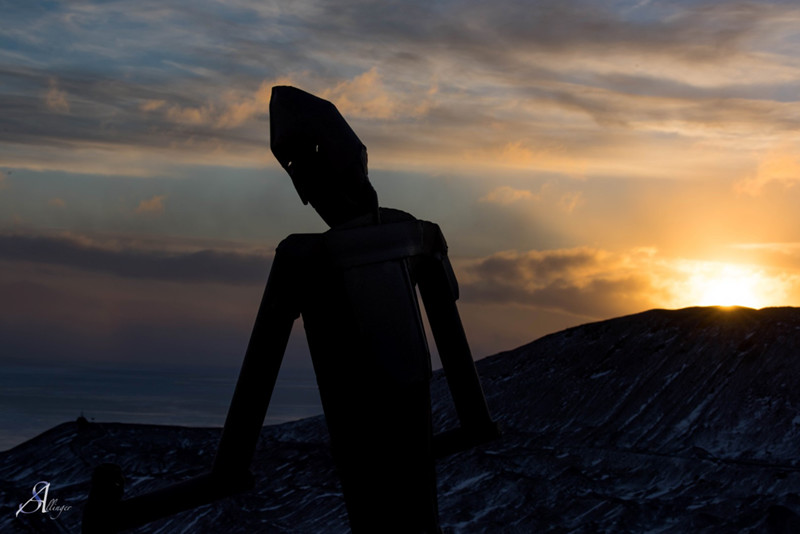
Photo Credit: Stephen Allinger
The setting sun silhouettes McMurdo Station’s skiing man statue with the Ross Ice Shelf in the background.
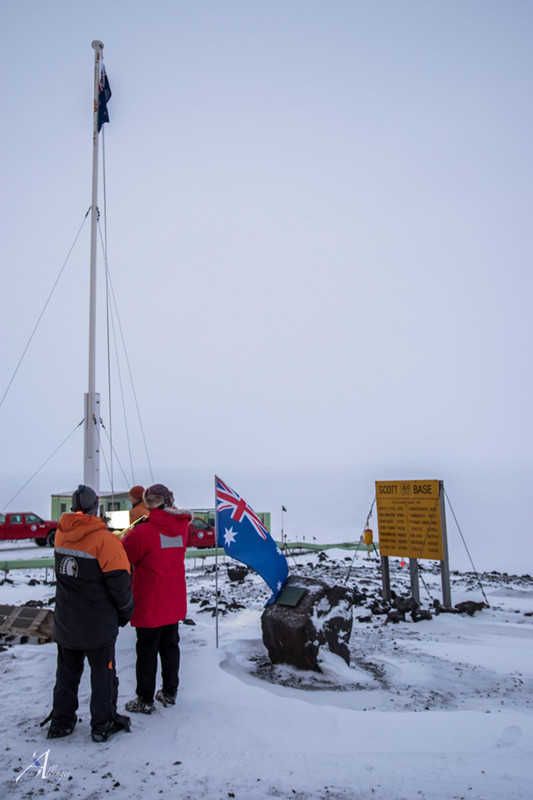
Photo Credit: Stephen Allinger
McMurdo residents join with the New Zealand winter crew for to commemorate ANZAC Day.
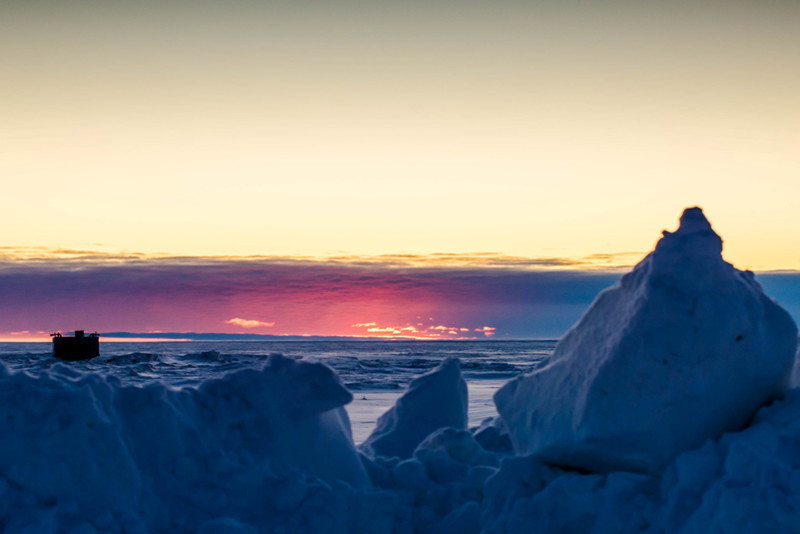
Photo Credit: Stephen Allinger
The sun dips below the horizon over the Ross Ice Shelf.
By Travis Senor, McMurdo Station correspondent
May 10, 2016
April marks the end of autumn at McMurdo. It is the last month with the sun above our horizon, and generally the first month where winter really begins to make itself felt. The darkness outlasts the light, overtaking it completely by mid-May.
But before the sun finally sets, there are still some loose ends of the austral summer to take care of. Following last year’s winter flights proof-of-concept tests, the month began with the arrival of an Australian Airbus. Landing a day ahead of schedule to take advantage of an optimal weather window, the plane carried the last 50-odd summer holdovers north to warmer climates, and brought a handful of hardy winter-overs south in exchange. Operations flowed smoothly and efficiently, providing excellent prep work for upcoming C-17 flights in June and July.
Late April is also when New Zealand holds the annual ANZAC (Australia and New Zealand Army Corps) Day commemoration at Scott Base. On April 25th, New Zealanders remember their countrymen who fell in the Gallipoli campaign against Turkey during the First World War. A seminal moment in the formation of New Zealand’s national identity, both within the British Empire (and later the Commonwealth) and independently, ANZAC Day marks this occasion with solemn remembrance. This year, several U.S. Antarctic Program personnel joined Scott Base staff in making commemorative remarks followed by a moment of somber reflection and silence for the fallen. McMurdo Station’s own Amy Varga played the trumpet for the traditional performance of “Last Post” and “Reveille.”
And as is the norm every year, April closed with a farewell to the sun as it set for the last time over McMurdo Station. Residents made the trip out to Pegasus Field on Sunday, April 24th to bid it goodbye one final time until its return in August. However, low clouds on the northern horizon masked the sun, preventing a truly proper send-off. Despite the obstructed view, the last light of the fading sun filtering through the clouds lit up the horizon in brilliant reds and pinks. While McMurdo Station will still have brief periods of light, by mid-May the station will be shrouded in the twenty-four hour darkness of polar winter.
The Sun Sets and Winter Begins
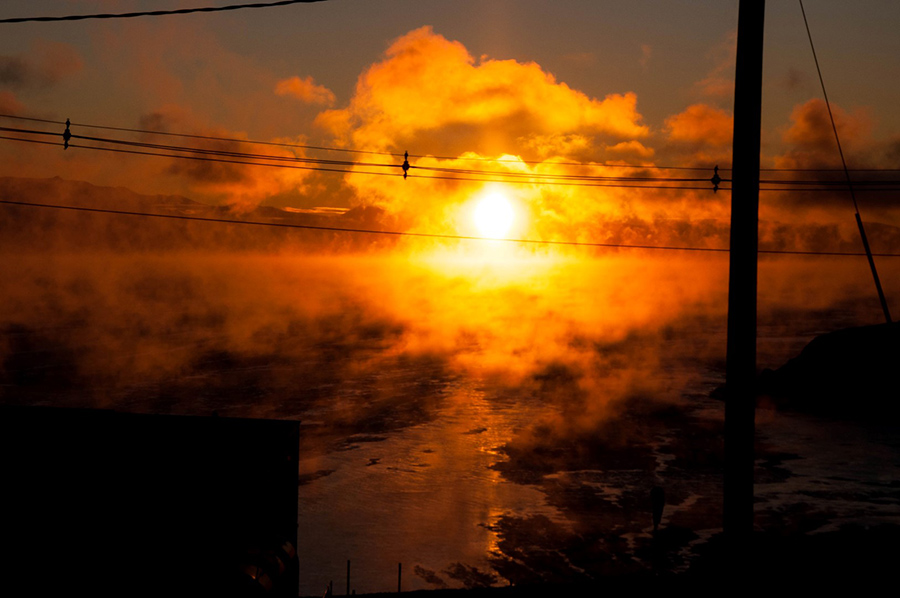
Photo Credit: Anna Hoessle
Fog over McMurdo Sound make for some spectacular sunsets.
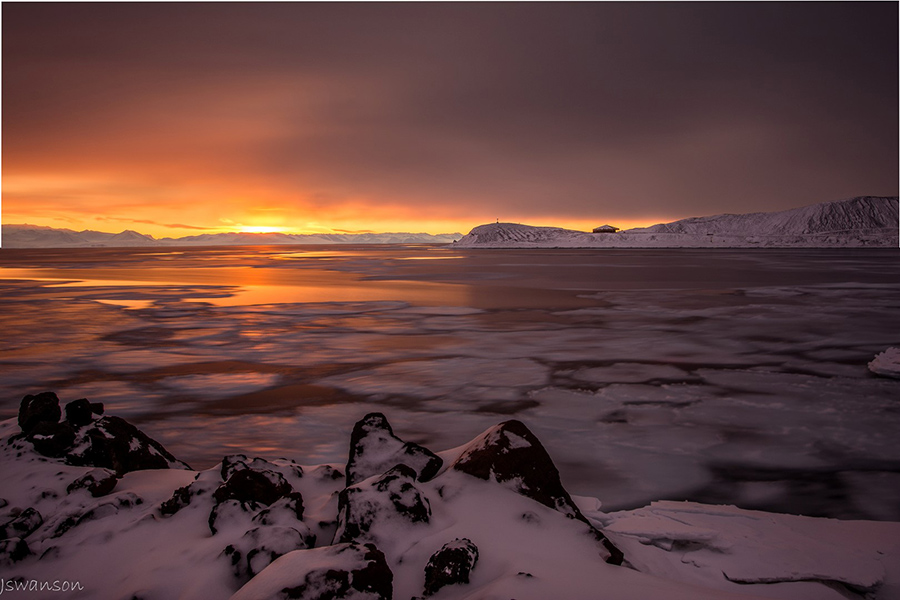
Photo Credit: Joshua Swanson
The sun dips below the horizon behind the Transantarctic Mountains past Hut Point.
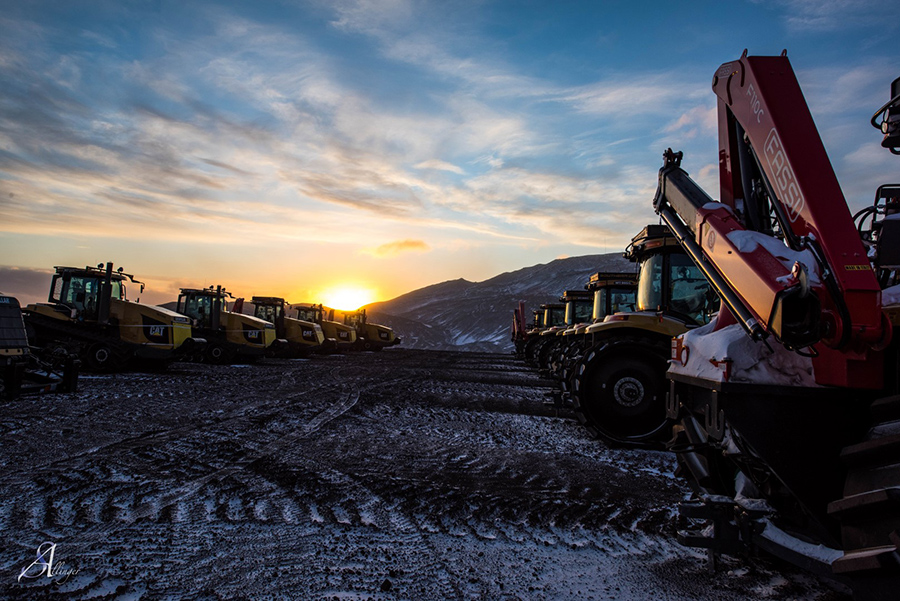
Photo Credit: Stephen Allinger
Parked tractors and heavy equipment will spend the winter hunkered down until spring returns.
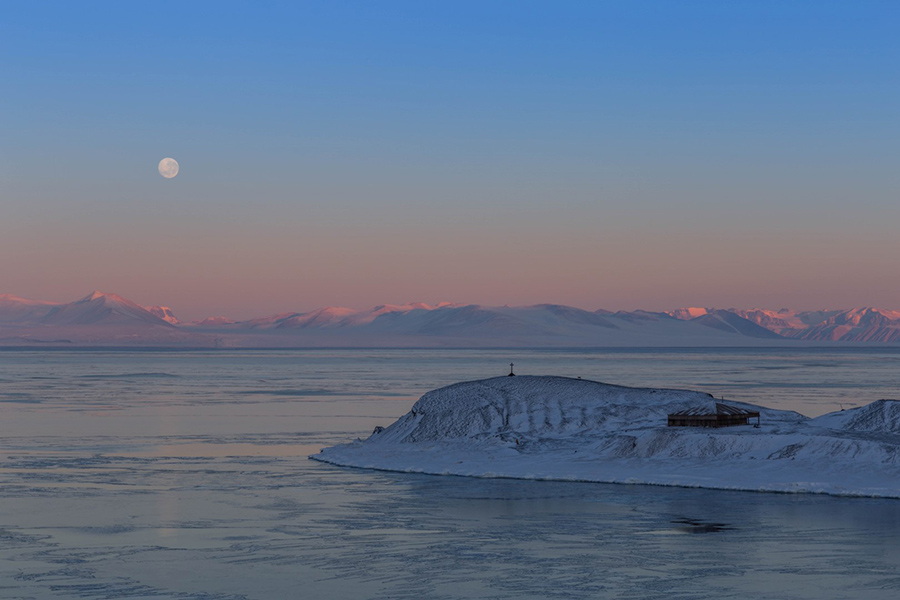
Photo Credit: Daniel Davenport
The moon rises over the Transantarctic Mountains, across from Hut Point.
By Max Spitzer, McMurdo Station correspondent
April 5, 2016
March marks the start of the winter season. The town’s population dwindled to less than 200 and every day the daylight hours shorten. Even the wildlife departed for winter; the seals, Adélie penguins and Skuas that had been staying around the station all but disappeared.
The changing season brought with it spectacular sunsets and sunrises, luring many novice and seasoned photographers outdoors to capture the stunning sun-draped landscapes. With the setting sun came the first sights of night since late October of last year. Stargazers were greeted with a bright full moon and bounteous stars. But the dwindling sun also meant a stark decline in ambient temperatures, with very few days ever seeing temperatures rise above zero degrees Fahrenheit. McMurdo residents could be seen wearing many more layers of clothing during the month of March.
March also presented McMurdo residents with their first two-day weekend of the year. Offered on the first weekend of each month in the winter, residents are allotted a special two-day weekend to catch up on any R&R that may be needed. The galley staff participated by hosting brunch on both Saturday and Sunday to allow residents the opportunity to sleep in.
The McMurdo Photography Club assembled for the first time this month since it stopped meeting at the end of last winter. Made up of over a dozen members, the club meets once a week to discuss, critique and foster the development of each member’s photography skills. Many of the photos captured by club members are shared around station and widely appreciated by town residents.
McMurdo said goodbye to its remaining New Zealand Defense Force crewmembers in March as it welcomed the arrival of a New Zealand Boeing 757. Historically, the departure of this flight marks the official start of the winter season. After it left, McMurdo residents held small get-togethers to celebrate the start of winter.
The neighboring New Zealand station, Scott Base, began hosting their weekly American Night dinners in March. Every week a dozen McMurdo residents are invited to have dinner at Scott Base. For those who attend, it comes as a pleasant change of scenery.
March was a lot quieter around town than during “mainbody,” just a month earlier, but the residents are hard at work preparing for their winter assignments ahead.
When the Ships Come into McMurdo
By Max Spitzer, McMurdo Station correspondent
February 15, 2016
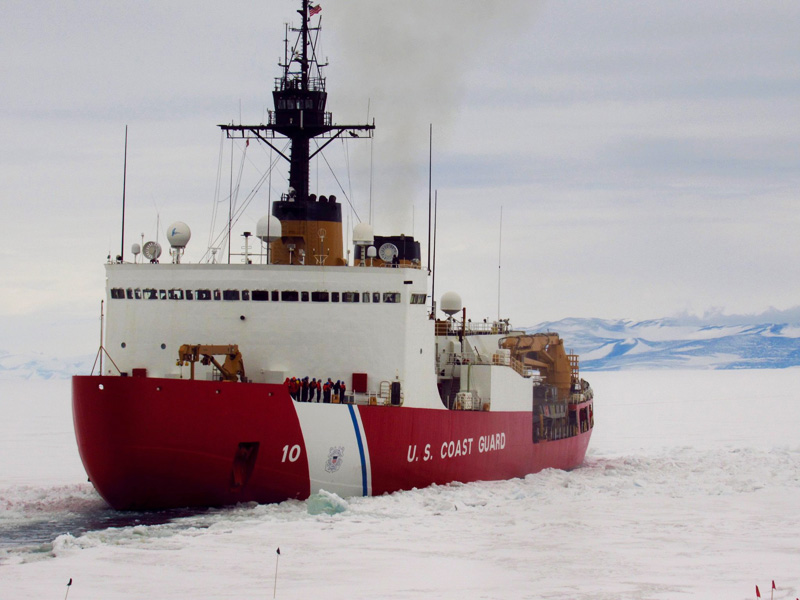
Photo Credit: Ted Goyal
The U.S. Coast Guard Cutter Polar Star cuts through the ice around Ross Island on its way to McMurdo Station.

Photo Credit: Ted Goyal
A penguin stands in front of the USCGC Polar Star after the sea ice broke out.
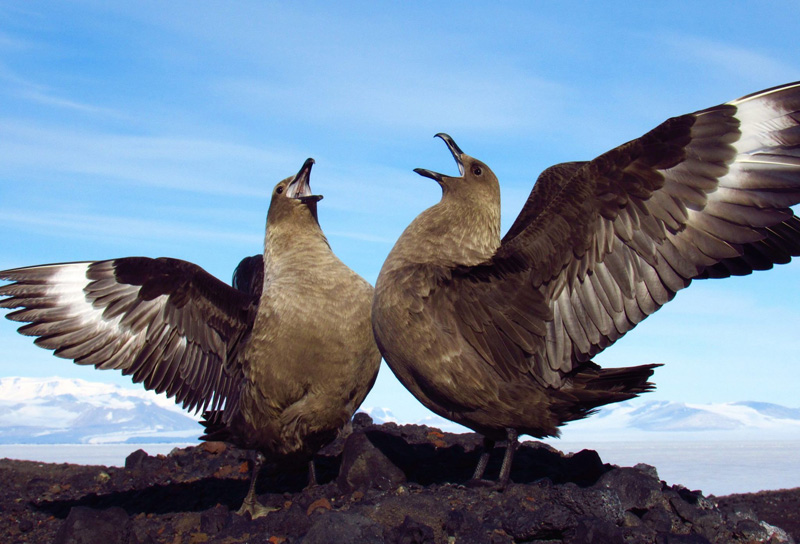
Photo Credit: Ted Goyal
Skuas are a common sight at McMurdo Station in the later part of the summer season.
January was a busy month at McMurdo. Two of the three ships that support station resupply docked at McMurdo’s ice pier, bringing important provisions for the coming year. The first to arrive was the U.S. Coast Guard Cutter Polar Star, an icebreaker which is critical to ensuring the safe passage of other vessels through the sea ice around Ross Island. The Star cleared a miles-long channel through the sea ice, exposing open sea for the first time in nearly a year. Along with the open water came sightings of orca and Minke whales—a first for many McMurdo residents and visitors.
Once the Polar Star had docked, station personnel were given tours of the vessel. After the Star’s crew had stretched their legs on land for a few days, they returned to the ship and departed in order to make way for McMurdo Station’s main resupply vessel, the aptly named MV Ocean Giant. A number of station residents assisted Navy personnel in docking the massive container ship, chartered from the Military Sealift Command (MSC) by the National Science Foundation (NSF). Once secured, the off-loading and on-loading processes began. For nearly a week, operations continued for 24 hours a day. Every department on station ramped up to assist.
Cargo operations for a vessel the size of the Ocean Giant were not an easy endeavor. It required the combined efforts of all station personnel, the MSC ship’s crew, and members of the U.S. Navy Cargo Handling Battalion and the New Zealand Defence Force. In the end, the operations were a success and the Ocean Giant departed for Lyttelton, New Zealand, and eventually the U.S.
January saw the successful launch of a high-altitude balloon-borne experiment for the long-duration balloon program, funded by a joint agreement between the NSF and NASA. The science group, GRIPS (Gamma-Ray Imager/Polarimeter for Solar Flares) attached their experiment to a high-altitude helium balloon to study various solar-flare phenomena. The balloon reached altitudes of 130,000 feet and stayed in the upper atmosphere for nearly 12 days.
Many deep-field science camps concluded their operations in January in preparation for austral winter. For many program participants, the end of their deployment to Antarctica is fast approaching. In the meantime, however, McMurdo residents will continue to make the most of an already very memorable and successful season.
End of the Year Happenings
By Max Spitzer, McMurdo Station correspondent
January 25, 2016

Photo Credit: Shaun Bonneau
Max Spitzer and Sue Novak at the top of Castle Rock

Photo Credit: Shaun Bonneau
Shaun Bonneau looking at Mt Erebus from top of Castle Rock
Though 2016 is well underway here at McMurdo, station residents made sure they didn’t welcome the New Year without first embracing the holiday season. Many work departments brought a taste of the holidays to their respective departments, adorning their offices with Christmas decorations and filling their refrigerators with mouthwatering seasonal treats like eggnog. Many hosted Christmas work parties, with several choosing to participate in Secret Santa and White Elephant gift exchanges. And the town became a little livelier with the added touch of Christmas lights and ugly Christmas sweaters.
Unlike in the United States this time of year, December is Antarctica’s peak of summer. Temperatures can often climb well above the winter temperatures found back home, and this year was no exception, with several days this month seeing temperatures exceeding 40 degrees Fahrenheit.
The warming weather of December welcomed the opening of access to climb the famous Castle Rock. Situated three miles outside of McMurdo station, the outcrop stands 415 meters high and offers unprecedented views of Mount Erebus and other landscapes surrounding the Ross Island peninsula. Many groups set out for its summit to snap holiday pictures for relatives back home.
The galley staff and cooks made sure all McMurdo bellies were full and happy during Christmas by hosting several Christmas dinners with all the delectable foods and treats one could expect back home. Residents dressed in their finest attires for the banquets, and all ate to their heart’s content.
For all those eager to get a head start on their New Year’s health resolutions, or simply to work off the added pounds of the holidays, the McMurdo recreation department hosted a pair of fun races across the station. They included a 10K run and the annual Ob Hill Up-Hill, a Christmas day race to the top of the famous hill overlooking McMurdo. Runners from both McMurdo Station and New Zealand’s Scott Base participated and all had a wonderful time.
Beyond the Christmas celebrations and festivities at McMurdo, many residents also took the time to reflect on all the things that made this year special. For many newcomers this season, it was the simple but profound realization that they made it here, to Antarctica, despite all the odds. And for many seasoned veterans, it was the realization that McMurdo, in all its splendor and peculiarity can still be a place to call home, at least for a season.
Station News Home Page


























